Mark Sisson's Blog, page 249
September 14, 2015
Dear Mark: Pegan Dieting and Exercising in Air Pollution
 For today’s edition of Dear Mark, I’m answering two questions. The first comes from Lucas, a man whose wife is unable to eat meat without feeling sick to her stomach. As a result, she’s interested in pursuing a Pegan way of eating, or “paleo-vegan.” Is it possible to be healthy while emphasizing plant foods and avoiding most meat? Is there anything she should watch out for? And last but not least, what’s the deal with commuting to work on your bike amidst urban air pollution? We all know that active commutes are supposed to be healthier than riding in a metal box, but do the negatives of breathing all those airborne particulates outweigh the positives of riding your bike? Find out what I think.
For today’s edition of Dear Mark, I’m answering two questions. The first comes from Lucas, a man whose wife is unable to eat meat without feeling sick to her stomach. As a result, she’s interested in pursuing a Pegan way of eating, or “paleo-vegan.” Is it possible to be healthy while emphasizing plant foods and avoiding most meat? Is there anything she should watch out for? And last but not least, what’s the deal with commuting to work on your bike amidst urban air pollution? We all know that active commutes are supposed to be healthier than riding in a metal box, but do the negatives of breathing all those airborne particulates outweigh the positives of riding your bike? Find out what I think.
Let’s go:
Me and my wife have been doing the Primal [Blueprint] diet for several years. For the past few months my wife has been cutting back on her meat intake. She is eating nuts/seeds and fruit for breakfast, a vegetable heavy lunch, and then a meat focused dinner with more vegetables. For the past few weeks, she has been getting nauseous every time she has had meat. We have read information about the Pegan Diet (combining Paleo & Vegan). What are your thoughts on this? Is it possible to eat healthy while eating Pegan? If so, what concerns should we take into account?
We have already been experimenting with the logistics of this and it hasn’t been an issue. She makes vegetables for dinner and I add a steak. Or she makes zucchini/mushroom lasagna and we put hamburger in half of it. My question is really just about the health concerns.
Lucas
Lucas, don’t worry too much. If she’s feeling sick after eating meat, it’s completely natural to want to avoid it. As I always say, avoid things that make you feel terrible. Plus, a healthy “Pegan” diet is totally doable. For years, my wife, Carrie, lived mostly vegetarian with some fish, eggs, dairy, and protein powder and she’s always been one of the healthiest people I know. She ate (and still eats) an insane volume of vegetation. It was easily the focus of her diet.
Concerns to keep in mind:
Watch your fat intake. Avoid super low-fat intakes, which are easy to fall into when you start restricting animals. Not so much because of anything inherent to eating more vegetables and fewer animals but because a lot of the vegan community falls squarely into the ultra-low-fat camp, and if she’s getting her advice there she may be lulled into avoiding fat. It doesn’t sound like it’ll be an issue for your wife — after all, she’s eating nuts and I’ve never seen lasagna that managed to be low in fat — but it’s something to keep in mind.
Eat enough protein. It needn’t be a high-protein intake, but don’t skimp on the protein. Because she’s not eating as much animal protein, and plant protein tends to be lower quality, she’ll probably need to eat more protein to cover her essential amino acid requirements. If she can’t handle land animal meat, which is typical, consider supplementing with a whey protein isolate. Also throw in some gelatin, to balance out the methionine/glycine ratio and at least simulate eating a whole animal (muscle meat and connective tissue).
Animal intake. Meat isn’t the only animal product. But animals produce some really nutrient-dense stuff while alive. If you can, stick with eggs, maybe some fermented dairy. She may even find shellfish and other types of seafood to be more acceptable than land-based animals. My wife was the same way, avoiding “meat” but loving a good slab of sockeye salmon with the skin on.
Carbs. Don’t try to eat like a gorilla. You can’t shovel in ten kilos of leafy greens every day and ferment them all into short chain fatty acids for fuel. Eat a few more carbs than you might otherwise to make up for the missing protein. Think tubers and fruit.
Primal doesn’t have to be a meat-fest. It’s not a meat-fest for me. The bulk of my dinner plate has always been comprised of vegetation.
What can a person do to make up for the missing meat?
Throw in some eggs.
Eat good, hard cheese, high quality yogurt, and real kefir.
Eat fish a couple times a week.
Learn to love oysters and mussels (which have no central nervous system).
Make tuna salad.
Have a handful of nuts.
If you find you tolerate them okay, try some properly-prepared beans. Soaking and/or pressure cooking them seems to improve digestibility.
Check out Angelo Coppola’s plant-based paleo way of eating for some other insights. He lost a ton of weight and got really healthy following a more standard paleo way of eating, and his new diet seems to be working for him.
Dear Mark,
I wonder if you have any views on how to reduce stress – physical and mental – on a cycle commute.
I currently commute about 5 km (3 miles) each way daily for work but this distance is about to treble. Good news for keeping active, and I am not unduly worried about the increased physical exertion (there are public transport options available too so I don’t overdo it), but I shall have to travel cross city and will be subjected to increased pollution levels. Is there anything you can recommend be done to offset the effect of noxious particulates?
Also, it’s not a particularly bike friendly city, with cyclists mostly sharing crowded roads with motor vehicles. Many motorists have poor awareness of cyclists and some actively consider them fair game for abuse; a fair few times I’ve arrived at my destination stressed by close calls. If this is likely to increase threefold too, what can I do to calm down? It’s fair to say I probably do take these things personally and an unwarranted horn blast will burn me for hours afterwards!
Many thanks for all you do.
Nikki
Exercising in polluted air presents a tricky quandary. Doing things that make us breathe hard are generally healthy pursuits. But what if the air we’re breathing is heavily polluted? Are we better off sticking with sedentary commuting — sitting in an air conditioned box as it whisks us to and fro? Or should we brave the particulate-laden air and trust the benefits of exercise outweigh the downsides of polluted air?
First, the bad.
Simply being in polluted air is bad enough. Epidemiological evidence has found links between polluted air exposure and a number of unpleasant health conditions:
Elevations in C-reactive protein and general systemic inflammation.
Cardiovascular and respiratory mortality.
Increased rates of lung cancer.
Hypertension in postmenopausal women.
Increased oxidized LDL.
When we breathe in polluted air, ultra fine particulates enter circulation to interact with cells in our body, especially endothelial and plasma cells, both of which are susceptible to particulate toxicity. And since many people default to mouth breathing when exercising, and this has been shown to push particulates deeper into the lungs than nose breathing, those who exercise in it are theoretically at greater risk from air pollution. Back when lead was added to gasoline (and proliferated through the air via exhaust), city runners often had higher blood lead levels than runners who trained in rural areas. And in a recent review, researchers posited that exercising in polluted air may dampen or inhibit the beneficial effects exercise normally has on brain function.
But there are good things about our response to exercising in polluted air, too.
When we exercise in polluted air, we ramp up immune activity to deal with the incoming airborne toxins. The study was done in runners, but this should also apply to cyclists, CrossFitters, speed walkers, curlers, and anyone else exerting themselves in polluted air.
In mice exposed to polluted air, aerobic exercise actually induces an anti-inflammatory response that may attenuate the damage wrought by air particulate exposure.
And there are ways to mitigate the (potential) damage (that I honestly don’t think is that big a deal):
Focus on nose breathing. The nose is a filter. Compared to nasal breathing, mouth breathing has been shown to increase penetration of particulates into the lungs. Exclusive nose breathing is hard, particularly when you’re pushing yourself, but it’s a worthy goal and definitely doable if you’re just commuting and not competing.
Choose a route that takes you through greener parts of the city (city park, tree lined streets, suburbs, creek trails) even if it means a slightly longer commute. Ensconcing yourself in greenery will provide a buffer for all the pollution.
Allow yourself enough time to take it slow. This will have the added benefit of reducing your stress levels, since you won’t be worrying about being late to work.
Keep tabs on air quality for your city. Here’s a handy tool for US zip codes. Here’s one for Europe, one for Asia, one for the Middle East, and one for the entire world.
But stick with the active commute. 5 km or 3 miles isn’t much, and you’re not going to be cycling like a madwoman all over the city. You’re not racing. You shouldn’t be sucking wind. If you do it right, cycling to work should take about as much exertion as walking.
That’s it for today, folks. I’d love to hear what you think about exercising in polluted air. Has anyone used a cycling mask? I understand they’re very common in London and some other major cities. And what about maintaining health on a Primal-esque plant-based diet. Have you tried it? Thanks for reading, and share you experiences in the comment board.




September 13, 2015
Weekend Link Love – Edition 365

Catch me on Episode #2 of the figureFit! Lifestyle Coaching Podcast with Liz Nierzwicki.
Research of the Week
Researchers have established a causal relationship between early-life exposure to farm dust and lifelong protection from asthma and allergies.
Compounds found in apples and green tomatoes may stave off age-related muscle atrophy.
Suburban lawns are foisting sex changes on frog populations.
Kids who drink the most sugar-sweetened beverages have higher triglycerides than kids who drink the fewest (who in turn have higher HDL).
Fecal transplant is still the best treatment we have for C. difficile infection, and it probably can help treat colitis.
New Primal Blueprint Podcasts

Episode 84: Gabrielle Reece: Host Elle Russ hangs out with beach volleyball legend Gabrielle Reece to discuss her parenting style, how she eats and exercises, which fitness mistakes she’d like to take back, what’s going on in Hawaii with pesticides, what it’s like being a type A personality married to another type A personality (former podcast guest Laird Hamilton), and much more.
Each week, select Mark’s Daily Apple blog posts are prepared as Primal Blueprint Podcasts. Need to catch up on reading, but don’t have the time? Prefer to listen to articles while on the go? Check out the new blog post podcasts below, and subscribe to the Primal Blueprint Podcast here so you never miss an episode.
Why Camping is So Great: The Benefits of Spending Time in the Great Outdoors
Personal Experiment: Does Daily Movement Make You Happier, More Energetic and Less Stressed?
Can Techies Improve Food?
10 Food Pairings That Make Surprising Nutritional Sense
Also, be sure to check out and subscribe to the (relatively) brand new Primal Endurance Podcast.
Weekly sweepstakes: Write a review for The Primal Blueprint Podcast or The Primal Endurance Podcast on iTunes and submit this form for a chance to win a Primal prize package. One new winner is chosen every week!
Interesting Blog Posts
How contact lenses affect your cornea.
Facebook isn’t real (but it can still be useful).
Media, Schmedia
Yet another sugar substitute rears its head.
Kevin Folta, a plant science professor and longtime “independent” GMO proponent, might not be so independent of industry influence.
Everything Else
As preschool free play declines to make way for academic rigor, some teachers are noticing an increase in children’s sensory and social issues. Kids are “frequently falling out of their seats” and “running into each other and the walls.” They’re “just different.”
Would you wear a refrigerator to lose weight?
Natto ice cream won’t melt (but will it have vitamin K2?).
Google’s trying to tackle diabetes.
Kickstarter campaign for a new adjustable standing desk that works with both kids and adults.
Recipe Corner
I’m not big on juicing, but you really can’t go wrong with carrot, ginger, lemon, and garlic.
Hungarian cherry soup. Just try it, folks.
Time Capsule
One year ago (Sep 15 – Sep 21)
Walking: The Human Condition – You’re a walker.
A Brief History of the Primal Movement – Look at how far we’ve come.
Comment of the Week
To the man with the perfect poop…his poop is his bread and butter!




September 12, 2015
Pork Debris
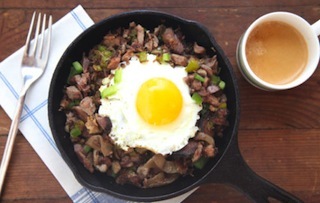 Pork Debris is a brunch dish that’s usually a happy accident. A pork shoulder is roasted the day before for dinner, there happens to be leftovers, so why not fry the pork up with an egg for breakfast the next morning? However, there’s nothing wrong with making Pork Debris a deliberate meal, either. As in, a pork shoulder goes into the Crock Pot at bedtime so you can wake up to the aroma of slow cooked pork for brunch.
Pork Debris is a brunch dish that’s usually a happy accident. A pork shoulder is roasted the day before for dinner, there happens to be leftovers, so why not fry the pork up with an egg for breakfast the next morning? However, there’s nothing wrong with making Pork Debris a deliberate meal, either. As in, a pork shoulder goes into the Crock Pot at bedtime so you can wake up to the aroma of slow cooked pork for brunch.
Pork Debris is a great recipe when you’re having people over for brunch and don’t feel like making much of an effort. The food basically cooks itself; you just have to fry a few eggs to throw on top. It’s a big, satisfying meal that will keep you well fueled through the afternoon.
This recipe is also a good reminder that any large cut of slow cooked meat, be it beef, pork or lamb, can several day’s worth of easy breakfasts. You don’t even have to bother with the egg on top. Just reach in the fridge, slice yourself some meat, and away you go.
Servings: 4
Time in the Kitchen: 20 minutes, plus 8 to 10 hours to slow cook the pork
Ingredients:
3.5 pound pork shoulder (twine and/or netting removed) (1.6 kg)
1 teaspoon kosher salt (5 ml)
1 teaspoon chili powder (5ml)
2 teaspoons smoked paprika (10 ml)
1 teaspoon cumin (5 ml)
½ teaspoon cinnamon (2.5 ml)
2 yellow onions, sliced
3 garlic cloves, sliced
1 green bell pepper, finely chopped
4 eggs, poached or fried
Instructions:
In a small bowl, mix together the salt, chili powder, smoked paprika, cumin and cinnamon.
Rub the pork shoulder down thoroughly with the spice mixture.
Lay the onions and garlic down on the bottom of the slow cooker. Set the pork on top, fat side up. Add 1/2 cup water. Cover and cook on low for about 8 hours until the pork is fork tender and easily pulls apart.
Remove the pork and strain the liquid from the slow cooker, reserving the onions and garlic.
Let the meat cool slightly, then shred the pork into bite-sized pieces, discarding any overly large pieces of fat. Set aside about 4 cups of shredded pork. Save the rest for another meal.
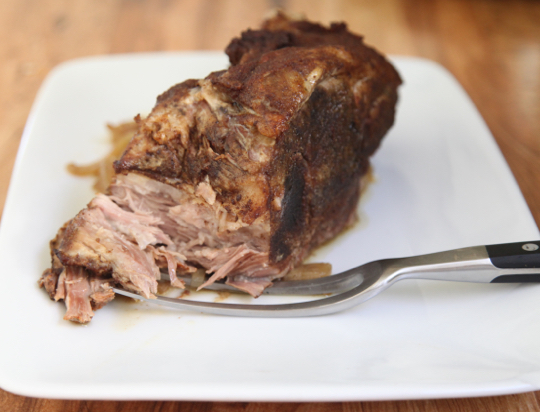
Heat a wide cast iron skillet over medium high heat. Add the 4 cups of shredded pork and the bell pepper. Fry until the pieces of meat get crispy around the edges.
Add the reserved onion and garlic from the slow cooker. Cook to heat through.
Serve the meat, adding a poached or fried egg on top.
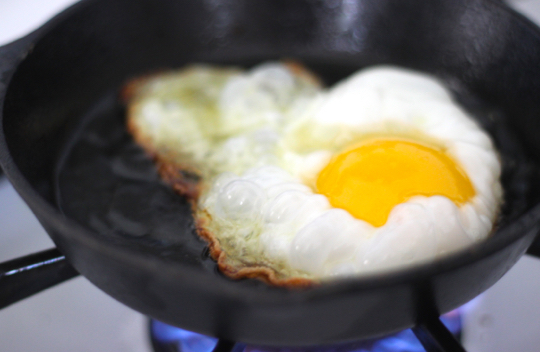
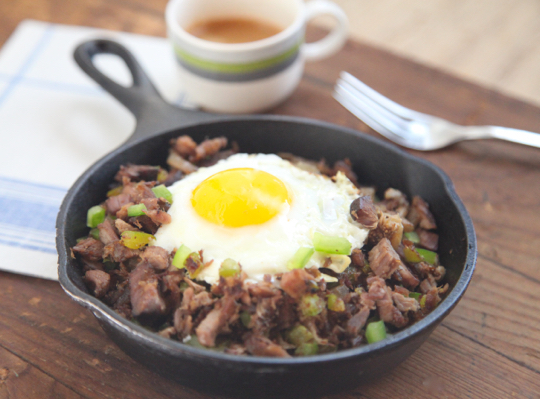


 Not Sure What to Eat? Get the Primal Blueprint Meal Plan for Shopping Lists and Recipes Delivered Directly to Your Inbox Each Week. Now Available as an App!
Not Sure What to Eat? Get the Primal Blueprint Meal Plan for Shopping Lists and Recipes Delivered Directly to Your Inbox Each Week. Now Available as an App!


September 11, 2015
A Better Way to Live
It’s Friday, everyone! And that means another Primal Blueprint Real Life Story from a Mark’s Daily Apple reader. If you have your own success story and would like to share it with me and the Mark’s Daily Apple community please contact me here. I’ll continue to publish these each Friday as long as they keep coming in. Thank you for reading!
 Though my primal journey isn’t one of losing hundreds of pounds or overcoming disabling digestion issues, it is one where my life has unquestionably improved from the sweets-loving, chronic cardio lifestyle in which I was buried a few years ago.
Though my primal journey isn’t one of losing hundreds of pounds or overcoming disabling digestion issues, it is one where my life has unquestionably improved from the sweets-loving, chronic cardio lifestyle in which I was buried a few years ago.
As a three-sport athlete in high school, I was desperate for activity after not playing any sports in college. My sister, who is an avid runner, convinced me to take up the sport, and I loved it. I ran a marathon my senior year of college, and worked and worked to improve my half marathon time. Addicted to running, I ignored the small injuries that kept cropping up. My I.T. bands were tight to the point of disabling pain, my lower back was tired, and my knees ached consistently.
My girlfriend (now wife) and I took a cross-country bicycle trip where I hit my not-very-deep rock bottom. After a pre-dinner snack of an entire pack of Oreos (not an exaggeration) one or two times a week on the trip, I came back a pound heavier than when I left. My body composition had changed, but it seemed ridiculous to me to have worked that hard and gained fat. That was July, 2011, and I haven’t eaten any SAD desserts again (though thanks to Danielle Walker, I’ve enjoyed some paleo treats).
Chronic cardio was the only way that I knew to fight the slow, insidious weight gain of the SAD, and, as I now know, you can’t slowly outrun an unhealthy diet. Though I wasn’t terribly overweight, I was certainly gaining a pound or two a year because of my insatiable appetite for food and beer.
As my wedding approached, I went to talk to a personal trainer, and he recommended the paleo diet, some resistance training, and tabatas. After doing a bit of research, I found MDA. I began to nibble away (pun intended) at my bad habits. I would do a paleo month, and then I would revert to the SAD. Then I would live primally for a couple more months to see how it felt. I was able to see the benefits of going paleo, but I wasn’t ready to make a full commitment yet.
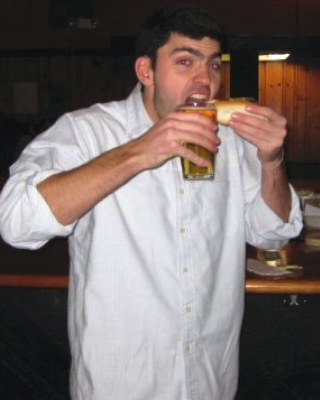 Finally, in July 2014 at 219 pounds and drinking a borderline ridiculous amount of IPAs, I decided to go primal for a longer stretch. My wife and I were about to leave on a trip to Iceland and the U.K., and I decided to eat thoughtfully on that whole trip. That iteration was more ketogenic than paleo, with lots of full fat dairy products and not many vegetables or fruits. Six days into the new lifestyle, my wife and I both noticed a physical difference. Although I had no specific sickness to overcome, my face was definitely thinner, and I was losing fat quickly. When we got home from the trip, I realized that I felt better and that sticking to this “diet” was what I wanted to do. The fat loss continued as the beginnings of some abs started to appear for the first time in my life.
Finally, in July 2014 at 219 pounds and drinking a borderline ridiculous amount of IPAs, I decided to go primal for a longer stretch. My wife and I were about to leave on a trip to Iceland and the U.K., and I decided to eat thoughtfully on that whole trip. That iteration was more ketogenic than paleo, with lots of full fat dairy products and not many vegetables or fruits. Six days into the new lifestyle, my wife and I both noticed a physical difference. Although I had no specific sickness to overcome, my face was definitely thinner, and I was losing fat quickly. When we got home from the trip, I realized that I felt better and that sticking to this “diet” was what I wanted to do. The fat loss continued as the beginnings of some abs started to appear for the first time in my life.
More interesting, however, was a mental acuity that I hadn’t even known was absent. I was better able to focus on whatever task was at hand, I began making the choice to meditate and play guitar every day, and I drank (and, more importantly, wanted to drink) less.
Another byproduct of the lifestyle is I have become obsessed with cooking and sourcing my food. My college roommate operates a livestock farm in Rhode Island called Wild Harmony Farm, and his meat and eggs are (in my humble opinion) the best in New England. Rather than hummus, whole grains, and fruit, the mainstays of my diet are leafy greens, whatever other vegetables I can get my hands on, bacon, beef, and pork chops straight from the farm. My kitchen has become a place to express creativity and partake in a borderline meditative practice. Wild Harmony Farm has given me the chance to butcher a slaughtered pig, and I have a chest freezer in the basement full of the healthiest food I can imagine.
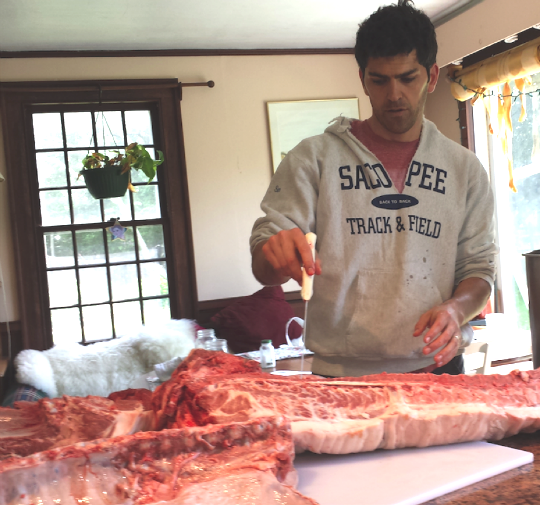
Admittedly, I began living primally with the goal of LGN. Whatever it takes, right? However, in retrospect, it has infiltrated every part of my life, as I feel more present and happier. I am gratefully in a cycle where making healthy choices begets making more healthy choices.
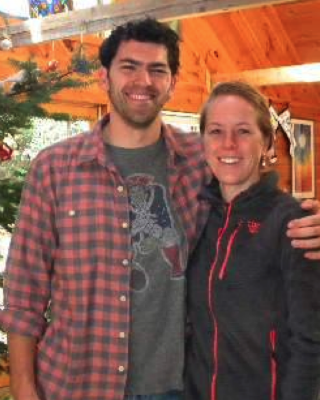 My last physical revealed that my cholesterol ratios are fantastic, my doctor (who, miraculously, is also paleo) was pleased with my choices, and I had dropped 30 pounds without starving myself or even feeling hungry.
My last physical revealed that my cholesterol ratios are fantastic, my doctor (who, miraculously, is also paleo) was pleased with my choices, and I had dropped 30 pounds without starving myself or even feeling hungry.
I still don’t have a six pack (a two pack maybe?), but I can tell there are muscles there now. I am not tempted to eat sugary foods or desserts anymore, and though I occasionally want a beer, and even less occasionally indulge, those cravings have largely gone away, because I have broken my sugar addiction.
Even more importantly, the lure of addictive substances has decreased as my sense of well-being has increased. I am not denying myself instant gratification. I simply no longer find “cheat” foods gratifying.
The primal lifestyle hasn’t been a hugely dramatic story for me. I felt okay before, and I feel better now. I was heavy but not obese before, and I am lighter and healthier now. Simply put, this lifestyle has made me eat, exercise, and live with a bit more joy and purpose. Can’t ask for too much more than that!
Sam




September 10, 2015
Why Camping Is So Great: The Benefits of Spending Time in the Great Outdoors
 I’ve always loved to camp. From my early days as a kid growing up in Maine (where it seemed like everyone camped), to my death-defying adventures with Outward Bound in the wilds of New England as a teen, to my current setup running a business in the Malibu hills, I’ve been a camper. Even when I’d dedicated my life to endurance training and had little time for anything else, I always made it a point to get away to the woods with the family for a few nights whenever I could. The reasoning was basic: it was relaxing, enjoyable, decompressing, and just plain fun. And that’s why most people camp. It just feels right, doesn’t it?
I’ve always loved to camp. From my early days as a kid growing up in Maine (where it seemed like everyone camped), to my death-defying adventures with Outward Bound in the wilds of New England as a teen, to my current setup running a business in the Malibu hills, I’ve been a camper. Even when I’d dedicated my life to endurance training and had little time for anything else, I always made it a point to get away to the woods with the family for a few nights whenever I could. The reasoning was basic: it was relaxing, enjoyable, decompressing, and just plain fun. And that’s why most people camp. It just feels right, doesn’t it?
But as is always the case, there’s more to it. Things that feel right (or taste right) often have distinctly positive physiological effects. So, why is camping so great? Why, even today, do campsites at Lake Tahoe or Yosemite disappear upon release faster than Taylor Swift concert seats? If you’re a skeptic of camping, be sure to read on. I’m sure I’ll win over some of you by the end.
It’s a rapid departure from your regular life without costing a fortune.
It’d be great if everyone could travel the world every time they had a little PTO saved up. But for most folks, going abroad, or even to another city in their home country, is cost-prohibitive. There’s the plane ticket. There’s the passport. There’s the lodging, the meals, the attractions, the ever-presence of locals whose entire livelihood depends on getting you to spend money. If you can swing it (and with smart planning, most people actually can), world travel is awesome and helpful and invigorating. But it can be just as world-changing to drive a few hours out of the city to a place where you can lay your tent down, start a campfire, and gaze up at the universe. And a whole lot less expensive.
It’s complete immersion in green space.
Remember that big post I wrote on the many benefits of spending time in or near green spaces (forests, parks, nature in general)? Yeah. Go review that and then realize that camping is living in those green spaces. As such, the benefits will be magnified.
It can improve your sex life.
Sex is extremely Primal (more so than grass-fed beef, even), and if we’re in a position to have it with a willing partner for whom we care, we should get as much as we both want. It’s a healthy, enjoyable habit. Unfortunately, we’ve managed to muck it up with cultural constructs of shame and inhibition and confusion that leave most people frustrated and dissatisfied with their sex lives. Sex is sacred, but many of us don’t get enough. One potential way to improve is to go camping with your partner. In one study, 500 couples from the UK rated their sex life before and after a three night camping trip. Before the trip, 47% were having sex once a month, 28% once a week, 23% once a year, and 2% every day. During the trip, most of the couples improved their sex lives, with over half reporting having sex “a lot more often” and 37% doubling their sex intake. As to the causes, 45% reported fewer distractions, 37% reported fewer worries, 9% said it was the increased physical proximity, 7% the earlier bedtime, and for 2% of the couples, just “being in the outdoors” was enough to increase friskiness.
It interrupts hyperconnectivity.
We cycle through apps and sites on an endless loop, from Twitter to Facebook to Reddit to email to HuffPo to nutrition message boards to MDA and back to Twitter, switching to a new one after consuming the last one’s content until we arrive back where we started, teeming with fresh updates. It doesn’t end. The stream of information is always there, buzzing at your hip, promising respite from the boredom of your mind. Camping is a nice way to force that interruption because, well, Verizon/T-mobile/etc haven’t yet found it productive to beam their signals that far into the wilderness. If you insist on bringing the phone along (because let’s face it, you will), take a Bluetooth speaker too and use it to play music. Don’t fritter away time staring at the screen hoping for a 4G signal that never arrives. Don’t be the guy climbing trees just to get a bar (be the guy who climbs trees just to climb trees). Load up some tunes beforehand and maybe take a few pictures — nothing else. You can also track your step count on all those hikes you’ll be taking, since most phones these days can do that on airplane mode.
When you remove the possibility of connectivity, you realize that being with yourself in the moment isn’t so scary.
It can be particularly restorative for cancer survivors.
A recent review of the evidence found that exposure to nature has many benefits for cancer survivors. It can enhance the quality of life for breast cancer survivors, increase the ability of survivors to concentrate their attention (attentional fatigue is common in this group), provide a source of self-esteem and belonging for children and adolescent cancer survivors, and reduce state-anxiety (with the “state” being “recent survivor of cancer”). Although the review wasn’t centered specifically on camping, camping is the most user-friendly way to immerse oneself in nature for an extended period of time and the results should apply here.
It’s a short-cut to mindfulness.
If you’re anything like me, formal meditation doesn’t work. I can sometimes do guided meditations, but even then sitting still gets tough. And quite often I’ll just fall asleep, which is fine but not the point. Many people find that “forced” meditation works far better than free meditation, where instead of sitting and paying attention to breath or a mantra or whatever, you do something that necessitates mindfulness. To me and millions of others, camping is one such thing. When you camp, you have to be there. I already mentioned the lack of connectivity to social media and the phone. That’s a big reason it helps center the awareness. But there’s also the stillness of the outdoors. You’re not contending with car horns or alarms and that couple fighting next door and cat fights at night and the din of traffic and general urbanity. You’re hearing the buzz of insects, the song of a bird, the crackle of the fire. These are qualitatively different sounds. Rather than interrupt, they raise awareness. They don’t intrude, they enrapture. They bring attention to the present moment. And when night falls and you all sit around that circle, the campfire becomes your entire world.
It enforces a healthy bed time.
How many of you stay up late despite reading all the studies and all the posts that stress the utter importance of a good night’s sleep? Heck, I write the things and I still stay up too late sometimes. Camping takes care of that for you by resetting your circadian rhythm.
It’s going back home.
Leaving concrete and cell phone towers and suburbs and traffic-choked roads and jobs behind to hang out in the woods for a few days isn’t just eliminating a source of stress; it’s returning to our ancestral ecosystem. And once you get over the bugs and the dust, and you get your tent set up and figure out a way to live with the mosquitoes, it really does feel like home.
How to do it right:
Cook good food. Don’t rely on freeze dried garbage or pop tarts (or the gluten-free equivalent, which I’m sure exists). Take the time to prep some great food, go shopping, and procure some solid cookware that you’re willing to get a little dirty and banged up. You can do some surprisingly gourmet cooking over a fire. Cast iron is your friend here.
Bring plenty of firewood. You gotta have that fire raging, or at least moderately so. Don’t run out. And you need enough firewood for breakfast.
Don’t bring LED lamps. You’re camping to escape all the artificial light we bathe ourselves in, so don’t ruin things by turning on the purest white LED once darkness falls. Stick to fire for your light.
Do at least two nights, but preferably three or more. One night of camping is a nice getaway, particularly if that’s all you can do. But to really get the camping effect, make it a two- or three-nighter. And if you really want to reset everything, make it a full week.
That’s about it. The rest of it boils down to gathering some friends, making the reservation (or finding a place that’s first come, first served), and just doing it. So go do it.
How do you like to camp? Where do you like to camp? If you haven’t already camped, are you going to? Thanks for reading.




September 9, 2015
Personal Experiment: Does Daily Movement Make You Happier, More Energetic and Less Stressed?
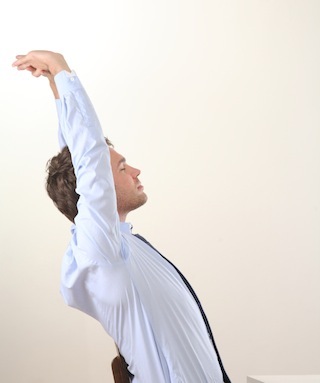 It’s 3 o’clock in the afternoon. What’s the condition of your backside? Can you feel your legs, or did at least one of them fall asleep a few hours ago? And your back? Neck, shoulders – how much tension are they carrying at this point in the day? Not to mention your mood and concentration? Does your attitude take a nosedive this time of day? Has your brain turned to mush? Did you just have to read the same set of instructions or email memo a couple of times because your mind wandered off? How often do you end up feeling like this in a typical afternoon?
It’s 3 o’clock in the afternoon. What’s the condition of your backside? Can you feel your legs, or did at least one of them fall asleep a few hours ago? And your back? Neck, shoulders – how much tension are they carrying at this point in the day? Not to mention your mood and concentration? Does your attitude take a nosedive this time of day? Has your brain turned to mush? Did you just have to read the same set of instructions or email memo a couple of times because your mind wandered off? How often do you end up feeling like this in a typical afternoon?
And…when was the last time you got up and moved – beyond a quick trip to the toilet or break room? I sense a lot of blank stares on the other side of this screen.
Are you one of them, or did you identify with any of the above scenarios? Consider your day for a moment – specifically your activity level. How compartmentalized is it?
Maybe you have your designated gym time, outdoor run or at-home routine. Excellent. Perhaps on the weekends you play with the kids, walk the trails with your partner or fit in a game or racquetball or Ultimate.
Now…what about those other hours?
You know – the ones you spend hunched over a keyboard or on an assembly line. The ones you’re sitting in meetings or at lunch with your coworkers. The ones you’re stuck in your car, trying to hold onto your sanity through an hour of traffic. The ones your aforementioned backside is glued to the couch.
The upsides to getting ourselves up and moving around throughout the day are so numerous, they’re almost overwhelming. We might understand the physical imperative for frequent movement – the role it plays in chronic disease and mortality risk, but we might not give it all the credit its due for its role in everyday satisfaction and concentration.
For instance, we might not appreciate the impact of moving on reducing anxiety (cue the performance reviews, project deadlines and drama-addicted coworkers) by growing the prefrontal cortex and promoting its communication with the brain’s fear center, in effect calming us – and maybe keeping us from turning an irritating office scenario into an emotional version of the Cuban Missile Crisis.
We might not understand that less than an hour of walking or otherwise moving at just half of our suggested “maximum heart rate” can significantly reduce our physical experiences of worry – as well as anger and cynicism. (The office cynic routine isn’t nearly as funny outside of sitcom land. Am I wrong?)
Maybe we don’t know that getting up and moving frequently is a boon to our executive functioning – the very capacity associated with goal attainment. Perhaps it eludes us that simple movement at various times of the day offers us a creative advantage that could help us at work or home – from the smallest tasks to the biggest decisions.
In fact, we might not understand that we can gain all of these advantages in a single day by putting in less time with our work when we simply commit a couple hours a day to exercise.
What do these prospects tell you about your daily process?
Let me propose a grand experiment. Those of you who have been around the blog a while know how much I like my self-experiments. How about some personal research on what movement does for you – on the impact daily continual physical activity has on your mood, energy levels and productivity. Forget the peer reviewed studies. Yes, they’re compelling, but be an irascible PIA who demands his/her own evidence. (I frequently place myself in this category.)
Make yourself a guinea pig for the sake of your health and curiosity. Put yourself under the microscope, and see what comes of it. And, if you’re unhappy with the positive results for any reason, trust me: you can always have your sedentary life back – 100% guaranteed, no questions asked (except a small, silent “Why????”)!
I’ve even put together a handy PDF for this purpose.
Use the first week as a control week. That means don’t do anything differently. Literally go to work, sit at your computer or work station. Don’t lift a finger you otherwise wouldn’t lift. Live the sedentary life you’re probably used to at work – with no guilt whatsoever because this week you’re doing it for the sake of science.
Simply rate the following items from 1-10 (10 being the best) for a full week. The items to rate are as follows:
Energy
Motivation
Health
Mood
Stress
Productivity
That’s it. Those of you who have used the The Primal Blueprint 90-Day Journal will recognize this list (with the addition of Productivity) as the metrics you used there, too.
Now for our second week. No more slacking for science. Here’s the new and simple addition to your day. Remember, it’s a short trial. If after a week you don’t feel better, you can chuck the whole plan. (Here’s betting you won’t though.)
For this second week, perform a set of some type of exercise movement (10 pushups, 10 air squats, 10 burpees, etc.) every hour from 9:00 a.m. to 5:00 p.m. That encompasses the work day for most of us. (If you’re on a different schedule, simply adapt to that.) I’d suggest even setting a timer for each 60 minute segment between movement stints so you won’t forget. Choose a movement that is moderately difficult for you and based on your fitness level. Scale the number of reps up or down according to your fitness level as well. The key thing here is to feel slightly out of breath and/or otherwise taxed after each set.
As you did in the previous week, rate the six metrics on a scale from 1-10. If you’re feeling particularly ambitious or just want to make the most of this scientific endeavor, take some notes on just what differences you’re seeing.
Were you able to get through a staff meeting without nodding off like you normally do? Did you have more ideas or initiative for a project than the first week? Did work get done more efficiently? Were you more patient with your kids, spouse or coworkers? Did you feel motivated to slant other behaviors toward healthier choices? Did you experience fewer or less noticeable slumps in energy or mood at certain times of day?
Okay, the floor is officially yours. Print off your PDF and start your self-experiment today. No time like the present after all! Start noticing what the effects of your “normal” sedentary/minimal movement are during the day, and be prepared for what you’ll observe in your life and work when you take on a modest but impactful change the following week.
Oh, and if you haven’t been introduced to Don’t Just Sit There! yet, check this out. This personal experiment is a great adjunct to that online multimedia program.
Enjoy, everyone, and share something of your process in the comment board. Thanks for reading!
Prefer listening to reading? Get an audio recording of this blog post, and subscribe to the Primal Blueprint Podcast on iTunes for instant access to all past, present and future episodes here.




September 8, 2015
Can Techies Improve Food?
 Technology has improved our lives, whether through the creation of new tools or by upgrading existing ones. Taxis were okay, but Uber and similar car service apps make them better (and self-driving cars will improve upon car service further). Craigslist makes classified ads free and easier to access. E-readers save trees and let people store entire libraries in the palm of their hands. Whereas world travelers used to have to wait a month for their postcard to reach a recipient (with another month for the reply), emails sent from Bangalore to Boston arrive in milliseconds. And perhaps most importantly of all, knowledge has been democratized. You can read anything from almost any time period using a device that fits in your pocket. You can talk to people halfway across the world in real time. Without technology, I wouldn’t be able to do what I do on a daily basis. Using the tools created by tech enthusiasts, I can reach millions of people every day and millions of entrepreneurs are creating new lives for themselves and new services and tools for others.
Technology has improved our lives, whether through the creation of new tools or by upgrading existing ones. Taxis were okay, but Uber and similar car service apps make them better (and self-driving cars will improve upon car service further). Craigslist makes classified ads free and easier to access. E-readers save trees and let people store entire libraries in the palm of their hands. Whereas world travelers used to have to wait a month for their postcard to reach a recipient (with another month for the reply), emails sent from Bangalore to Boston arrive in milliseconds. And perhaps most importantly of all, knowledge has been democratized. You can read anything from almost any time period using a device that fits in your pocket. You can talk to people halfway across the world in real time. Without technology, I wouldn’t be able to do what I do on a daily basis. Using the tools created by tech enthusiasts, I can reach millions of people every day and millions of entrepreneurs are creating new lives for themselves and new services and tools for others.
But are there limits to technological progress? Can technology improve everything?
We’ll find out. There’s talk of a “food revolution” brewing in Silicon Valley, helmed by engineers and entrepreneurs convinced they can do food better than both nature and traditional agriculture.
There’s Soylent, the food replacement shake that promises to render home kitchens obsolete save for dedicated hobbyists and save millions of hours better spent working and “being productive.” They’ve raised over $20 million in venture capital funding and are taking orders for Soylent 2.0, due to ship in October.
There’s Hampton Creek, the food tech startup seeking to replace eggs with plant-based substitutes and make food healthier and safer “for everyone, everywhere.”
Now, I’m not one that thinks pre-made foods have absolutely no place in a Primal eating plan. There are some incredible food manufacturers doing some really useful and important things using only fresh ingredients. There’s Exo, whose cricket bars are raising awareness about how delicious and nutritious insects can be. Heck, I’ve made my own foray into the food world with Primal Kitchen™ Mayo and Primal Fuel. In these cases what’s really provided is convenience without sacrificing quality or nutrition. And for most people these days, when time is so scarce, that’s genuinely worth something. I know that matters to me and I’m willing to pay a premium in many cases. But what’s important is that the food doesn’t suffer. That the quality is maintained. That nutritional compromises aren’t made. And that these foods remain adjuncts to an otherwise healthy diet.
The human brain is this planet’s ultimate technological innovation to date, and we’ve used it to improve food before. Watermelons were seedy, fibrous gourds before we used breeding to expand and redden their edible placentas to encompass the entire interior. The wild ancestor of corn, teosinte, contained only about a half dozen kernels per ear, each covered in a stony, inedible casing. Wild bananas are riddled with seeds and mostly inedible to humans. And generations of human intervention created the delicious, well-marbled wagyu breed of cattle. Our ability to wring edibility out of harsh wild plants and unpredictable half-ton beasts with selective breeding has been a huge boon to us as a species.
But bananas, watermelons, corn and wagyu cattle are still complex biological systems. They are food, and we treat them like it. We’re not trying to break down, catalogue, and reduce them to their constituent parts, transforming them into something barely recognizable.
Should we really “optimize” food in this way? Can we?
Rob Rhinehart, the founder of Soylent, thinks so:
Two years ago today I decided to bet my life on the idea that food could be empirically rebuilt. I theorized that food and the body were reducible and a novel foodstuff could be superior to that which was naturally occurring.
I’m very skeptical. In theory, we can recreate all the possible components of a given food — if we could only identify them. With the relatively infantile base of knowledge we currently possess, I don’t think any engineered food powder will contain all the micronutrients we get from real food.
Infant formula has improved by leaps and bounds over the years. They’ve introduced DHA, prebiotics, various specific nutrients like taurine, inositol, and choline, and played with the macronutrients to get it closer and closer to the real thing. Yet it’s still inferior to breast milk. Now, some time out in the future, maybe we’ll finally pin it down. Maybe parents won’t have to take leave at all. They’ll just strap the kid to the android wetnurse, refill its lab-grown mammary sacs with optimized formula, and head straight back to work. Progress!
But you see my point, don’t you?
Every major time we’ve tried to engineer food, we’ve encountered unforeseen consequences.
Margarine was supposed to improve upon butter. It was worse.
Vegetable oils were supposed to improve upon animal fats. They seemed awesome (cheaper, more profitable, “healthier”) but were worse.
Trans-fats were supposed to replace saturated fats. They looked good on paper but were way, way worse.
We can’t foresee what we don’t know. If we’re constructing our diets using isolated, reduced nutrients, we risk missing out on food-based nutrients we have yet to catalogue or whose importance we have yet to uncover. If we construct our diets using food, we get those unknown nutrients — even if we have no idea we’re consuming them.
Look at all the components that make up a simple banana. People usually cite this image as a rejoinder to chemical scaremongering, but it also illustrates the folly of thinking we can engineer the perfect food by mixing together powdered grains and synthetic vitamins. That is a huge list of “ingredients” in a simple food. Does Soylent include every last component comprising the food it attempts to replace?
And even when it comes to what we do know about what’s in food, Soylent falls short (PDF).
It’s got vitamin K1, not vitamin K2. The latter is the form that protects bone and heart health and which is missing from most normal diets. You can convert K1 to K2 if you have the right gut bacteria, but I’m not sure eating Soylent will support that conversion.
It’s got vitamin D2, not D3. D3 is better-absorbed by humans than D2.
It’s got soy protein, which makes for good vegan-friendly headlines but is of questionable nutritional worth when compared to whey protein, particularly in the context of resistance training and weight loss.
It’s fairly low in protein and the protein isn’t of sufficient quality. You can get away with plant-based protein as long as you’re eating a lot of it and low protein intakes as long as it’s animal-based protein. But lower levels of plant-based protein may not be adequate for sedentary people, let alone active people.
Where’s the prebiotic fiber? The latest (1.5) version of Soylent powder comes in at 3 grams of fiber per serving. Were it raw, the oat flour supplying the bulk of the carbs in Soylent would provide a good amount of resistant starch, but since they go rancid quickly the majority of oats on the market are heated.
It contains no phytochemicals beyond the ones found in the oat fiber/flour and soy protein components. Cocoa flavanols? Nope. Blueberry anthocyanins? None. The founder’s skeptical of their importance in our diets, doubting most “humans in history were even getting broccoli and tomatoes.”
Broccoli and tomatoes aren’t the only plants with phytochemicals. Every plant has them, and every human throughout history has consumed plants. Even historically low-plant food cultures like the Masai and the Inuit regularly consumed wild plants high in phytochemicals. The Masai cooked their meat with anti-parasitic spices, drank bitter (read: tannin- and polyphenol-rich) herb tea on a regular basis, and used dozens of plants as medicines (PDF); the Inuit utilized a wide variety of phytochemical-rich plant foods including berries, sea vegetables, lichens, and rhizomes. They also made tea from pine needles, which are high in vitamin C and polyphenols.
In related news, Hampton Creek has promised to render eggs obsolete and replicate their gelling, emulsifying, and binding culinary properties using specialized textured pea proteins. They’ve got a cookie dough and mayonnaise on store shelves and hope to bring pancake batter and a realistic scrambled egg substitute to market. They talk big, touting their ever-growing in-house database of novel plant proteins they plan to use to emulate animal foods.
I get the motivation. Wanting to save the world is laudable. Trying to eliminate the need for cruel and destructive egg farming is a just cause. But from a health and nutrition standpoint, these aren’t the Eggs 2.0 they and their supporters are hoping.
Hampton Creek’s responses to these interview questions are telling:
When asked about the status of the scrambled egg substitute and whether its nutritional profile was similar to that of actual eggs, they answered only the former (“hopefully by next summer”) and ignored the nutrition question.
In another answer, they reiterate that they’re “not focusing on the strict nutritional details at this time… so even if it is a little healthier, (e..g no cholesterol in your mayo) that is a start.” So that’s “healthier”: a lack of cholesterol. They’ve fallen into the same trap as the Soylent people — failing to realize that nonessential nutrients can still be beneficial. And the failure to mention the choline, vitamin A, DHA, folate, and biotin real eggs provide indicates that those nutrients will also be missing from the egg substitute.
Mostly, they don’t seem to care about the nutritional details. It’s about the environment, or humaneness, or cruelty. But for any food to be a worthwhile caloric source for humans, it must contain adequate micronutrition. If you’re going to replace a source of nutrition as complete as the humble egg, you’d better know what you’re doing.
Those are the two most egregious attempts at better feeding through technology, but they certainly won’t be the last. Again, I understand the sentiment behind both Soylent’s total meal replacement and Hampton Creek’s mock eggs. The techies may very well one day address the issues I’ve raised and the issues that arise in the future, and their current efforts may beat the standard American junk food diet (particularly if you throw in some colorful fruits and vegetables, a bit of liver, some raw potato starch, and maybe some whey protein), but they smack of hubris.
And when your stated goals are the replacement of the foods we’ve used for hundreds of thousands of years to fuel our brains and our cells and build enzymes and endogenous antioxidants and muscle tissue and grow new life inside our wombs, hubris doesn’t cut it.
But the potential micronutrition deficits aren’t even my major issue. My biggest qualm is that eating Soylent (even if it’s got every nutrient we require) or ditching real pastured eggs for some equi-nutritional glop that comes out of a carton and lasts for years in the fridge is missing the point of food. Food is supposed to taste good. It’s supposed to be chewed, savored, and shared with others. About the most depressing communal meal I can imagine is a bunch of 20/30-somethings sitting around together, staring into their smartphones, and sipping Soylent. Optimizing food is like optimizing sex; while I’m sure there’d be a few people interested in a pill or device that produced instant orgasms so they could get back to work, that’d be missing the point entirely. It’s the journey that makes the destination.
They’re trying to solve a problem that doesn’t really exist. Is stocking the kitchen with Soylent a better option than ordering a bunch of pizzas and cokes for your engineers so that they can get back to work right away? Maybe, maybe not. But the vast majority of people look to food not just to sustain their health and provide the necessary calories, but also to bring pleasure to their lives. To create and maintain connections with our dining companions and to do what humans have been doing for millennia: creating, sharing, and enjoying meals made out of raw plants and animals with our own hands.
Thanks for reading, everyone. I’d love to hear from you down below. What’s your take on the techies’ attempts to optimize, improve, and replace real food?




September 7, 2015
Dear Mark: Ketosis and Cancer, Probiotic Dosing Patterns
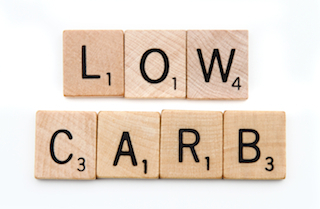 For today’s edition of Dear Mark, I’m answering two questions. First up, is the ketogenic diet an effective cancer treatment? There’s a lot of hype in the media and online world about ketosis, but what does the research really say? Then, I discuss a few different probiotic dosing patterns. Should you take them every day? Is there a benefit to switching brands from time to time? Should you ever megadose probiotics? How did ancient and preindustrial people “supplement” probiotics?
For today’s edition of Dear Mark, I’m answering two questions. First up, is the ketogenic diet an effective cancer treatment? There’s a lot of hype in the media and online world about ketosis, but what does the research really say? Then, I discuss a few different probiotic dosing patterns. Should you take them every day? Is there a benefit to switching brands from time to time? Should you ever megadose probiotics? How did ancient and preindustrial people “supplement” probiotics?
Let’s go:
Hi Mark,
I’ve read a few studies about the use of a ketogenic diet as an effective treatment option for cancer. Basically, the studies purport that cancer cannot survive on ketones, but instead require glucose to proliferate. I.e., eliminate glucose, starve cancer cells. I was hoping to get your opinion on this – can tumors really be subdued with strict ketosis?
Thanks!
Mikkela
First I’ll point out that there are over a hundred types of cancer. What’s good (or bad) for one type might not be good for the next type. So when we discuss the effects of ketosis on cancer, we have to be extremely specific. And above all, we must remember that none of this constitutes medical advice. I’m not qualified to give it and the science is extremely preliminary.
With that said, several lines of evidence have lead many researchers to conclude that ketogenic diets may have efficacy in cancer treatments.
In general, cancer cells utilize glucose at a higher rate than normal tissues.
Hyperglycemia worsens the prognosis of some cancer patients, like those with liver, breast, pancreatic, and female reproductive cancers.
Diabetes is associated with an elevated risk of many cancers, including liver, pancreatic, colon, and breast.
Diabetics who use glucose-lowering agents like metformin have a lower risk of cancer mortality.
But just because high blood sugar seems to exacerbate cancer progression doesn’t mean ketosis will halt or even slow it. Does it?
Numerous animal and in vitro studies have found that ketogenic diets or ketone administration can improve survivability, slow tumor growth, increase tumor cell death, and improve the efficacy of traditional cancer therapies. One study found that injecting ketones into chow-fed mice increased tumor growth. Interesting, but injected ketones on top of a non-ketogenic lab chow diet isn’t analogous to how ketogenic dieters produce ketones. I’m not sure we can draw any conclusions from that one.
There have been a few human studies, mostly testing the effects of ketogenic diets on brain cancer patients. The evidence is mixed.
In a group of 16 advanced cancer patients, ketogenic dieting improved quality of life, including emotional processing, in those who could tolerate the diet. In a recent pair of case studies, glioma patients showed tumor progression on a ketogenic diet. The tumors actually began producing enzymes necessary to metabolize ketones, suggesting that some gliomas can adapt to ketogenic diets and switch over to the new fuel source. In addition to reporting the case studies, researchers also reviewed the human keto diet/brain cancer literature as a whole, concluding that some brain cancer patients respond well to ketosis while others see no benefit. Those who do benefit enjoy slowed tumor progression. That said, only one of the human case studies covered in the review used ketosis as a monotherapy; all others used keto in conjunction with more traditional cancer therapies (radiation, chemotherapy).
As for why rodent cancer patients do so well on keto, they’re usually genetically homogenous lab creations, not “wild-type.” Their tumors all respond more or less identically to various inputs, whether they be radiation, supplements, or ketogenic diets. Humans are wild-type, and tumors from different humans have different degrees of ketone metabolism and thus different responses to ketosis. Those whose tumors express fewer ketolytic enzymes will likely fare better on ketogenic diets than patients whose tumors express more ketone-metabolizing enzymes.
Still, when used as an adjunct to cancer therapy, ketogenic diets appear to be safe and free of serious side effects. If I were diagnosed with a brain cancer, I’d probably try a strict ketgeonic diet. It’s safe, and very well might improve my prognosis, quality of life, and response to treatment. In other words, ketogenic diets under the supervision of your oncologist probably can’t hurt to try. But don’t assume you can “just go keto” and forego all other treatments.
The jury’s still out, but I expect we’ll get some real answers in the near future.
Hi Mark,
Any thoughts on the benefits/drawbacks of cycling probiotic intake? Either by cycling on-periods and off-periods…or by switching to new strains after a period of time?
Thanks in advance,
Ryan
To my knowledge (and I try to stay apprised of the research in this particular area), researchers haven’t yet formally examined the question.
In the absence of hard data, I look to traditional and ancestral precedent. Not as the final word, but a starting point for informed speculation. So let’s speculate.
If the best-studied extant tribe of hunter gatherers — the Hadza — are any indication, it followed a steady pattern punctuated with mega doses. Mega-doses? The largest acute exposures to exogenous bacteria occur when the Hadza make a kill. To wash off the blood and bits of viscera caked on their hands, they use fistfuls of partially-digested plant matter from the still-warm guts as hand scrubbers. Not soap and water. Not hand sanitizer. Stomach sauerkraut teeming with microbes.
Then, they slice the raw stomach into bite-size pieces and eat it on the spot. No cooking, no parboiling to remove contaminants. Straight up stomach sashimi.
And finally, after removing as much fecal matter from the colon as possible, they toss it on open flames to cook for a few minutes. Charred on the outside but mostly raw along the bacteria-rich inner walls, the colon is sliced and served. That’s a literal megadose of colonic bacteria.
Underlying those megadoses was a consistent, close relationship to the microbial world around them. Extended breastfeeding. Co-sleeping with your entire family. Digging for tubers, gathering honey, hunting. That’s the backdrop against which they interacted, lived, handled: the dirt, dust, bugs, plants, animals, and each other, all teeming with microbes.
If hunter-gatherers obtain their “probiotics” passively by residing in the natural, de-sterilized environment, others cultures get theirs via fermented foods.
In Korea, kimchi is a staple food eaten with every meal.
Japan has soy sauce, natto, miso, and other interesting items.
In much of the Mid East, India, the Mediterranean nations, Russia, and Eastern Europe, fermented dairy (yogurt, cheese, or kefir) is eaten or drunk every day.
Western Europeans have their cheese habit.
The Mongols conquered the world on fermented mare’s milk.
For the most part, exposure to probiotic happened daily for most people throughout history, whether via fermented food staples or passive contact with environmental microbes, often both. I can’t think of anyone more divorced from their natural microbe-replete environment than modern Westerners. We think kimchi is “smelly.” We buy pickles soaked in vinegar, not lacto-fermented brine. We live in a world of hand sanitizer, antibiotics, draconian hand washing measures, cupboards full of antimicrobial chemicals. We spend our lives almost entirely indoors. We often need probiotic supplements supplements just to be normal. (And because I personally wanted the best and it didn’t exist in the marketplace, I created Primal Flora.)
Now, if you’re the type to demand randomized clinical trials for every decision you make, stick to daily “normal” dosing. Every probiotic study I’ve seen uses 1 to 2 pills a day. That’s the only concrete data we have to go on, and we know that works if the strains being used are useful for the effect being sought. Could cycling work better? Perhaps, but I haven’t seen any evidence and simply eating a variety of fermented foods (each with its own stable of microbes) is a kind of cycling. Might megadoses speed up colonization and realization of health benefits? I wouldn’t be surprised.
As I see it, there’s precedent for both steady intake of probiotics and infrequent megadoses. Probably both at once. Less so if you’re eating fermented food regularly.
Thanks for reading, everyone. Take care and have a great rest of the week. As always, I’d love to get your input on today’s questions!




September 6, 2015
Weekend Link Love – Edition 364

Research of the Week
All dogs appear to have descended from ancient European wolves.
A myopia gene causes nearsightedness in kids, but only if they stay indoors reading or doing “nearwork” and avoid playing outside.
Statins cause muscle damage by disrupting our mitochondria.
Roundup: the incredible new weight loss hack!
New Primal Blueprint Podcasts

Episode 83: Katy Bowman and Mark Sisson: Katy and I hang out and talk about our new joint project, Don’t Just Sit There, a comprehensive multimedia guide to overcoming the prolonged sedentary periods that characterize modern life and threaten the function of our genes and tissues. You’ll learn why standing workstations aren’t often enough, how modern ergonomics creates its own set of problems, and what you can do to stay active while working in the office.
Each week, select Mark’s Daily Apple blog posts are prepared as Primal Blueprint Podcasts. Need to catch up on reading, but don’t have the time? Prefer to listen to articles while on the go? Check out the new blog post podcasts below, and subscribe to the Primal Blueprint Podcast here so you never miss an episode.
Why Getting Fit Isn’t the Best Exercise Motivation (and 10 Better Reasons to Move Today)
13 Ways to Move More Throughout the Day (Even While at Work)
Also, be sure to check out and subscribe to the (relatively) brand new Primal Endurance Podcast.
Weekly sweepstakes: Write a review for The Primal Blueprint Podcast or The Primal Endurance Podcast on iTunes and submit this form for a chance to win a Primal prize package. One new winner is chosen every week!
Interesting Blog Posts
Chris Masterjohn weighs in on the fermented cod liver oil controversy.
Yep, breast milk is pretty incredible.
Your tendons on cake (and how to improve the situation).
Media, Schmedia
An alternate approach to counting calories.
The trouble with most diet advice (and diet studies).
How we’re affecting the pasta industry.
Everything Else
Here’s what to do with all that zucchini you grew but can’t eat fast enough.
The sock that hopes to replace shoes.
Putin and Medvedev working out in complete and utter silence. I can’t look away.
The man with the perfect poop.
I would love to go to viking school.
Coming soon: insect oil?
Speaking of Roundup, British wheat farmers “are doing a similar thing by spraying weeds but they’re also spraying the wheat itself and they’re doing this in order to kill it and make it easier to harvest. That’s how it gets into the food and that’s the use of glyphosate that we’re calling for a ban on.”
Recipe Corner
Got some extra potato starch laying around? Make the Japanese-style fried chicken the folks at Serious Eats liked best (which just happened to be gluten-free). Switch up the oils if you like.
Grapefruit and ginger tuna tataki is light, refreshing, and perfect for a summer’s afternoon.
Time Capsule
One year ago (Sep 8 – Sep 14)
12 Signs You Need to Eat More Protein – Are you eating enough?
Rajio Taiso: Why You Should Start Doing Light Morning Workouts – The benefits of easy but consistent movement sessions in the morning.
Comment of the Week
The only Primal approved Cliff bar is using the edge of a cliff as a pullup bar.
– I like that.




September 5, 2015
Tuna Mango Salad with Citrus Poppy Seed Dressing
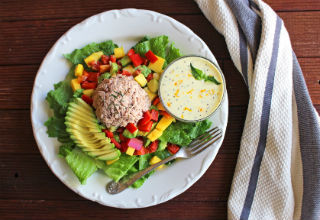 This is a guest post from Kendra Cardoza, author of the blog
paleopaparazzi.com
.
This is a guest post from Kendra Cardoza, author of the blog
paleopaparazzi.com
.
Hey hey! Kendra here. You may know me from my blog paleopaprazzi.com or my IG account where I post #KendrasSuperSalads. I’m SO excited to be guest posting on Mark’s Daily Apple today as this is my first time! As you can probably guess from the intro, I LOVE salads. I used to despise them before going paleo 2.5 years ago, but now I just cannot get enough of them! I live and breathe salads almost everyday! I’ve even have my husband addicted to them, yay for salads! I created a droolicious (my new favorite word) recipe using Primal Kitchen™ Mayo and Safe Catch Tuna that I cannot wait to share with you!
I love that Primal Kitchen Mayo is void of any nasty additives you find in conventional mayo and is made with one of my favorite healthy fats, avocado oil. Avocado oil has so many health benefits, and Primal Kitchen Mayo is chock full of it! It’s a great base for salad dressings because full fat dressings actually help us to absorb vitamins like A, D, E, K and other nutrients in our salads. Fat-free salad dressings just negate the whole point of eating a salad, so go get your full fat dressing on and sprinkle it like confetti!
I also love that Safe Catch Tuna tests every single tuna fish for mercury, making them the lowest mercury tuna of any brand. Combine these two together and you’ve got a winner winner tuna dinner!!
If you love this recipe and are craving more delicious food and health tips, come join me over at Paleopaparazzi.com and be sure to sign up for my newsletter so you won’t miss a thing. So, without further ado, I present, Tuna Mango Salad with Citrus Poppy Seed Dressing!
Servings: 2
Time in the Kitchen: 25 minutes
Citrus Poppy Seed Dressing
Ingredients:
½ cup of Primal Kitchen Mayo
2 tablespoons fresh-squeezed orange juice
1 tablespoon poppy seeds
1 teaspoon fresh-squeezed lemon juice
1/2 teaspoon orange zest
1/4 teaspoon raw honey
Salt and pepper to taste
Directions:
Combine and stir all ingredients together in small bowl
Store in refrigerator while you prepare the salad
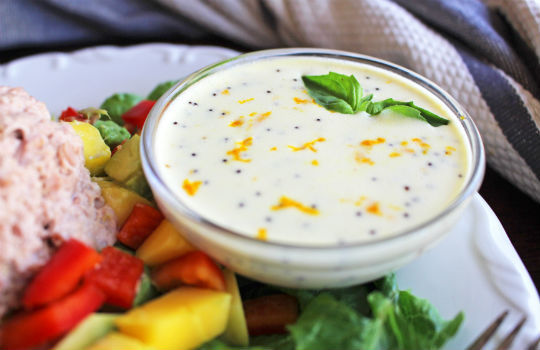
Tuna Mango Salad
Ingredients:
1 can Safe Catch Tuna
1 tablespoon Primal Kitchen Mayo
2 romaine hearts
1 large mango
1 large red bell pepper
1/2 medium cucumber
1 large avocado, sliced
Directions:
Mix the can of Safe Catch Tuna and tablespoon of Primal Kitchen Mayo together in small bowl
Store the tuna mixture in the refrigerator while you prepare the salad
Rinse all vegetables and chop
Peel and slice avocado
Dry wet romaine hearts with a towel or spin in a salad spinner to remove excess water
Divide chopped romaine lettuce and evenly distribute between 2 plates
Add chopped and sliced vegetables to the top of the chopped romaine hearts
Use an ice cream scooper to evenly distribute tuna mixture on top of each salad
Top salad with the citrus poppy seed dressing and enjoy!!
This salad is so fresh and easy to make, you’re going to want it for every meal!
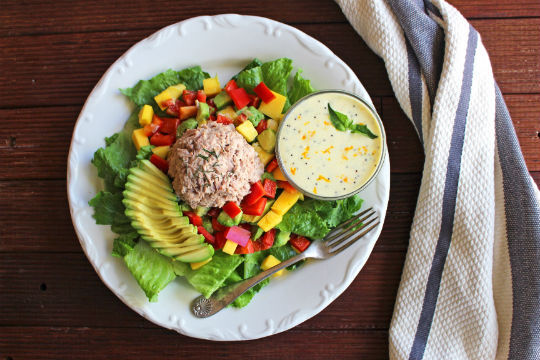
Not Sure What to Eat? Get the Primal Blueprint Meal Plan for Shopping Lists and Recipes Delivered Directly to Your Inbox Each Week. Now Available as an App!



Mark Sisson's Blog
- Mark Sisson's profile
- 199 followers



